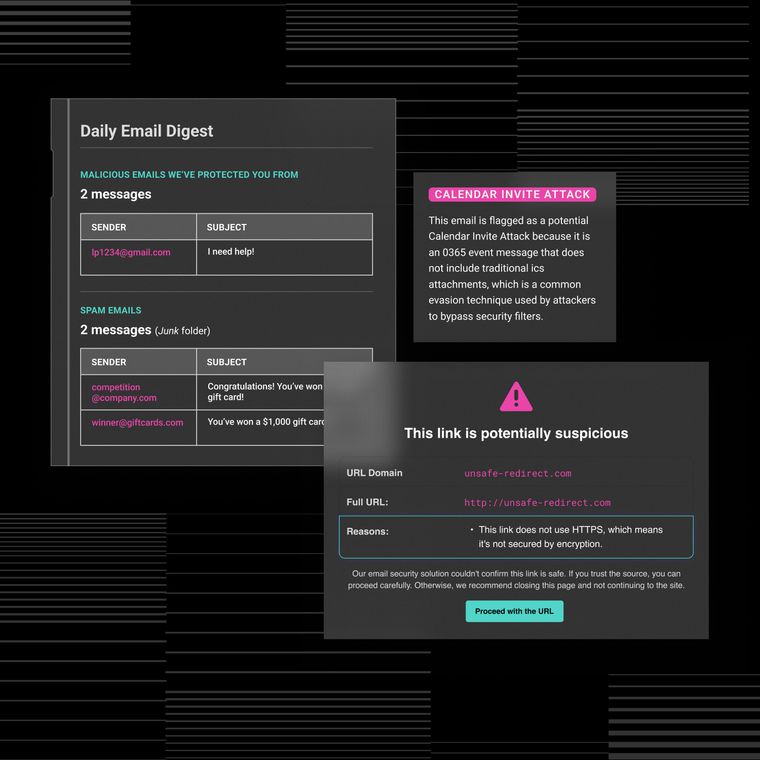The Ultimate Guide to Cloud Security Assessment: Identify and Mitigate Critical Vulnerabilities
Run a cloud security assessment to find and fix your most urgent vulnerabilities.
July 20, 2025
Cloud security assessments provide the clarity and control you need to run cloud workloads without jeopardizing your business. A structured assessment evaluates every layer of your environment such as identities, data stores, networks, APIs, and logs, against industry benchmarks and your own risk appetite, creating a real-time picture of where you stand in the shared-responsibility model.
This cloud security assessment guide outlines how this process can help identify and mitigate critical vulnerabilities.
Strategic Importance of Cloud Security Assessments
Cloud security assessments need to be treated as a leadership tool because they translate sprawling technical detail into precise business risk, giving you the evidence to act decisively. Here’s why:
Gain Full Cloud Visibility and Control
Without a structured assessment, blind spots multiply such as shadow IT, unused privileges, and open storage buckets can linger for months. A comprehensive review inventories every workload, account, and network rule, then benchmarks each configuration against best practice.
By surfacing issues like excessive permissions or disabled logging, you regain control over who can access what and when. That visibility allows you to shut down dormant accounts, enforce least privilege, and tighten security group scopes before attackers exploit them. The assessment transforms an opaque cloud footprint into an environment you can measure, monitor, and manage.
Anchor Digital Transformation in Risk Intelligence
Boards green-light digital initiatives when you demonstrate that security keeps pace with innovation. Assessments deliver that confidence by mapping misconfigurations to business-critical apps and showing exactly how a new SaaS rollout or container platform affects risk exposure.
The process aligns technology investments with acceptable risk thresholds, letting you prioritize remediation that protects revenue-generating services first. Connecting findings to business impact enables you to effectively advocate for resources and demonstrate that modernization efforts enhance your security posture.
Operationalize Zero Trust Principles
Zero trust demands continuous verification of every user, device, and workload. Assessments make that philosophy operational by spotting over-permissive roles and missing MFA on privileged accounts, enabling you to enforce identity rigor at scale.
Evaluating network paths uncovers unintended any-to-any connectivity that violates micro-segmentation goals. Each discovery feeds concrete actions like restrict tokens, add MFA, segment workloads, that move you closer to true zero trust. The assessment cycle ensures that these controls remain effective, catching configuration drift the moment it occurs.
Prove Compliance and Reduce Financial Exposure
Regulators focus on evidence. A documented assessment provides auditors with evidence that encryption, logging, and access controls are functioning as required. When you can produce a trail showing how misconfigurations were identified and remediated, audit cycles shorten and fines become far less likely.
Misconfigurations drive regulatory non-compliance and privilege escalation; eliminating those issues lowers the chance of multi-million-dollar penalties or shareholder lawsuits stemming from breaches. Clear metrics such as percentage of assets with encryption enabled, allow you to brief executives in language they value: reduced financial risk and uninterrupted business operations.
Understanding the Assessment Lifecycle
Cloud security assessment operates as a continuous strategic discipline that validates the effectiveness of controls as your environment evolves. Treating evaluation as an iterative cycle allows you to detect new misconfigurations early and verify that previous remediation efforts remain effective.
Each assessment cycle ensures that access controls adhere to least-privilege principles, storage buckets remain private, and logging remains intact despite rapid infrastructure changes. Configuration drift occurs within hours in dynamic environments. Recurring assessments realign your environment with policy baselines and industry benchmarks, preventing drift from becoming exposure.
Here are the four factors should drive your assessment schedule:
Asset criticality and sensitivity – Revenue-producing workloads and highly regulated systems require monthly or real-time posture validation
Compliance requirements and audit cycles – ISO 27001 and SOC 2 frameworks recommend regular evidence collection; aligning assessments with quarterly timelines is a common best practice that streamlines audit preparation
Threat landscape changes – Newly weaponized vulnerabilities or attack techniques demand immediate reassessment of affected services
Major infrastructure or application changes – Migrations, new SaaS integrations, and significant code releases should trigger ad-hoc reviews to confirm inherited controls remain effective
Anchoring cadence to these drivers prevents both over-assessing low-risk assets and under-assessing business-critical systems. Visual dashboards that map assessment dates to these triggers simplify the justification of frequency to auditors and board members.
Core Assessment Phases: A Leadership View
A disciplined six-phase assessment model enables you to identify blind spots, translate them into business-aligned risks, and drive measurable improvements.
These include:
1. Define Strategic Scope
Start by framing the assessment around what matters most to the business. Catalog every workload, data store, and entry point, and not just what IT manages formally. Incomplete asset inventories are a major contributing factor to missed vulnerabilities.
Next, classify each asset by confidentiality, integrity, and availability requirements, then map those classes to compliance obligations such as HIPAA or PCI DSS. That mapping drives a tiered scope: workloads with regulated data or high revenue impact get full configuration and penetration testing, while low-impact assets receive lighter checks.
Lastly, confirm ownership for every resource, including shadow projects spun up by DevOps, so you can assign findings to accountable teams immediately after the assessment.
2. Evaluate Controls and Configuration Hygiene
With scope locked, interrogate the security basics that attackers exploit first. Over-permissive roles, missing MFA, and orphaned credentials appear in most evaluations. Excessive IAM privileges remain a top enabler of breaches.
That said, here are the steps you need to take:
Scan storage buckets for public read/write access and confirm encryption at rest.
Review security groups and firewall rules for 0.0.0.0/0 exposures. Inspect APIs for missing authentication or rate limiting, then verify that centralized logging captures every administrative action.
A quick win is enforcing least-privilege roles and mandatory MFA, which serve as critical preventive steps.
Benchmark each control against CIS or similar baselines to convert vague "best practices" into concrete pass/fail criteria.
Strong configuration hygiene eliminates the low-hanging fruit that both external attackers and malicious insiders exploit first. Regular audits of permissions, access controls, and logging create the foundation that more advanced insider threat detection builds upon.
3. Expose Hidden Risks
Your organization likely has more digital assets than you realize, and many exist outside your security oversight. Here's how to find what's hiding in plain sight:
Hunt for shadow workloads using cloud-native discovery tools and automated crawlers that scan beyond your standard deployment pipelines. These often reveal test environments, personal projects, or quick fixes that became permanent but never got proper security review.
Follow the money trail by cross-referencing billing records against known resources to flag anything consuming budget that no team claims ownership of. Unclaimed resources often lack proper access controls or monitoring.
Audit dormant credentials that still hold production access, especially service accounts and API keys that teams forgot about after projects ended. These sleeping credentials become perfect insider attack vectors.
Review third-party integrations with broad OAuth scopes that may have been granted during rushed implementations. Apps with excessive permissions can become insider threat multipliers.
Compare resource tags against governance policies to catch workloads that bypass security groups, encryption requirements, or access controls through configuration drift.
Hidden assets represent some of your highest insider risks because they operate without normal oversight or monitoring. Regular discovery sweeps turn these silent liabilities into managed, protected resources before they become attack vectors.
4. Quantify and Rank Risks
Raw findings only matter when they influence decisions. That’s where you need to score each issue by likelihood and impact, then place it on a heat map so executives can see at a glance where attention must go first. Combine qualitative matrices with Factor Analysis of Information Risk (FAIR) methodology to express top risks in financial terms.
Also, establish a clear risk-appetite threshold where anything scoring "high" or above that monetary line mandates action within a defined service level agreement (SLA). This disciplined prioritization prevents remediation teams from being overwhelmed by tickets that deliver little risk reduction.
5. Direct Remediation Efforts
Turn priorities into results through cross-functional sprints where security leads supply the technical fix, asset owners validate impact, and compliance teams track evidence for auditors.
Address the highest-impact issues first by locking down administrator roles and enabling multi-factor authentication (MFA) across all accounts. Convert public buckets to private and enforce server-side encryption while tightening security group rules to the minimal internet protocol (IP) range required.
Embed fixes into infrastructure-as-code templates so misconfigurations cannot reappear during the next deployment. Track progress in a shared dashboard that shows residual risk trending downward with each sprint, creating visibility that maintains momentum and demonstrates measurable security improvements to stakeholders.
6. Enable Continuous Improvement
A security evaluation is only valuable if its findings inform an ongoing program. Integrate results with your Cloud Security Platform Management (CSPM) so every control failure instantly triggers alerts and auto-remediation where feasible.
Continuous scanning also catches configuration drift before auditors or attackers do. Schedule reassessments after major cloud architecture changes and include improvement metrics, such as mean time to remediate high-risk findings, in quarterly security reports. Over time, this feedback loop transforms one-off reviews into a data-driven engine that continually hardens your cloud posture.
Governance and Reporting for Security Leaders
Strong governance transforms raw assessment data into actionable intelligence that informs investment decisions, drives compliance, and fosters continuous improvement. Here are the steps to take in this direction:
Build Dashboards That Resonate
Your first priority is a real-time dashboard that surfaces the handful of metrics executives actually use to judge cloud risk. Focus on the exposure rate, which is the percentage of cloud assets with critical misconfigurations, alongside the mean time to remediate for high-severity findings.
Include MFA coverage across privileged identities and encryption adoption for data at rest and in transit. Automating these metrics is straightforward with Cloud Security Posture Management tools and provider logs.
Continuous collection is essential because misconfiguration drift can occur within hours in a DevOps pipeline. By keeping the view uncluttered and trend-based, you grasp whether risk is shrinking or expanding at a glance.
Map Results to Compliance Frameworks
Certifications and audits are critical for cloud security assessment because they protect revenue and brand trust. Convert every evaluation control into the language of NIST CSF, ISO 27001, or SOC 2 so compliance gaps appear alongside technical ones.
An open S3 bucket violates NIST PR.DS-1 (data at rest protection) and ISO 27001 A.8.2 (information classification). Tools that automate this mapping allow you to generate auditor-ready evidence with a click.
Present a simple table that shows each control group, pass/fail status, and planned completion date; this turns sprawling requirements into a concise action plan executives can fund and track.
Selecting the Right Tools and Partners
Effective cloud security assessment platforms require proven automation, complete visibility, and intelligent prioritization.
This includes:
Automation and Scale: Platforms should deliver automated security control assessments that map resources to compliance frameworks in real time. Viable tools inventory thousands of assets across Amazon Web Services (AWS), Azure, and Google Cloud without agents, using provider Application Programming Interfaces (APIs) to trace data flows even in container clusters.
Artificial Intelligence (AI)-Powered Prioritization: AI-powered risk prioritization separates noise from critical misconfigurations by correlating identity paths, external exposure, and exploitability.
Integration and Expertise: Platforms should forward findings to your Security Information and Event Management (SIEM), open tickets in ServiceNow, and trigger guardrails in Terraform through Representational State Transfer (REST) APIs. Expert oversight remains critical for validating alerts and translating technical issues into business risk.
Ultimately, choosing a platform that unifies automated, cloud-wide visibility with AI-driven prioritization and expert-integrated workflows transforms periodic assessments into continuous, measurable reduction of cloud risk and compliance gaps.
Continuous Cloud Security Assurance with Abnormal
Uncovering misconfigurations and access gaps is only the first step. Abnormal turns those findings into continuous cloud security assessment and real-time defense. The platform ingests identity and configuration signals from every major cloud provider and automatically baselines the behavior of every user, application, and workload.
When a deviation, such as a long-dormant admin account reactivating or an OAuth token siphoning data, matches Abnormal’s threat models, the platform enforces the right control instantly, from triggering MFA to terminating the risky session. By intervening at machine speed, advanced attacks never reach your mailboxes, file stores, or collaboration hubs.
Abnormal also delivers continuous posture validation: every configuration, privilege, and policy change is evaluated against the same threat models, giving you an always-current view of residual risk without manual scans or one-off assessments.
Expose and neutralize cloud risks before attackers can exploit them. Request your personalized demo today.
Related Posts
Get the Latest Email Security Insights
Subscribe to our newsletter to receive updates on the latest attacks and new trends in the email threat landscape.


